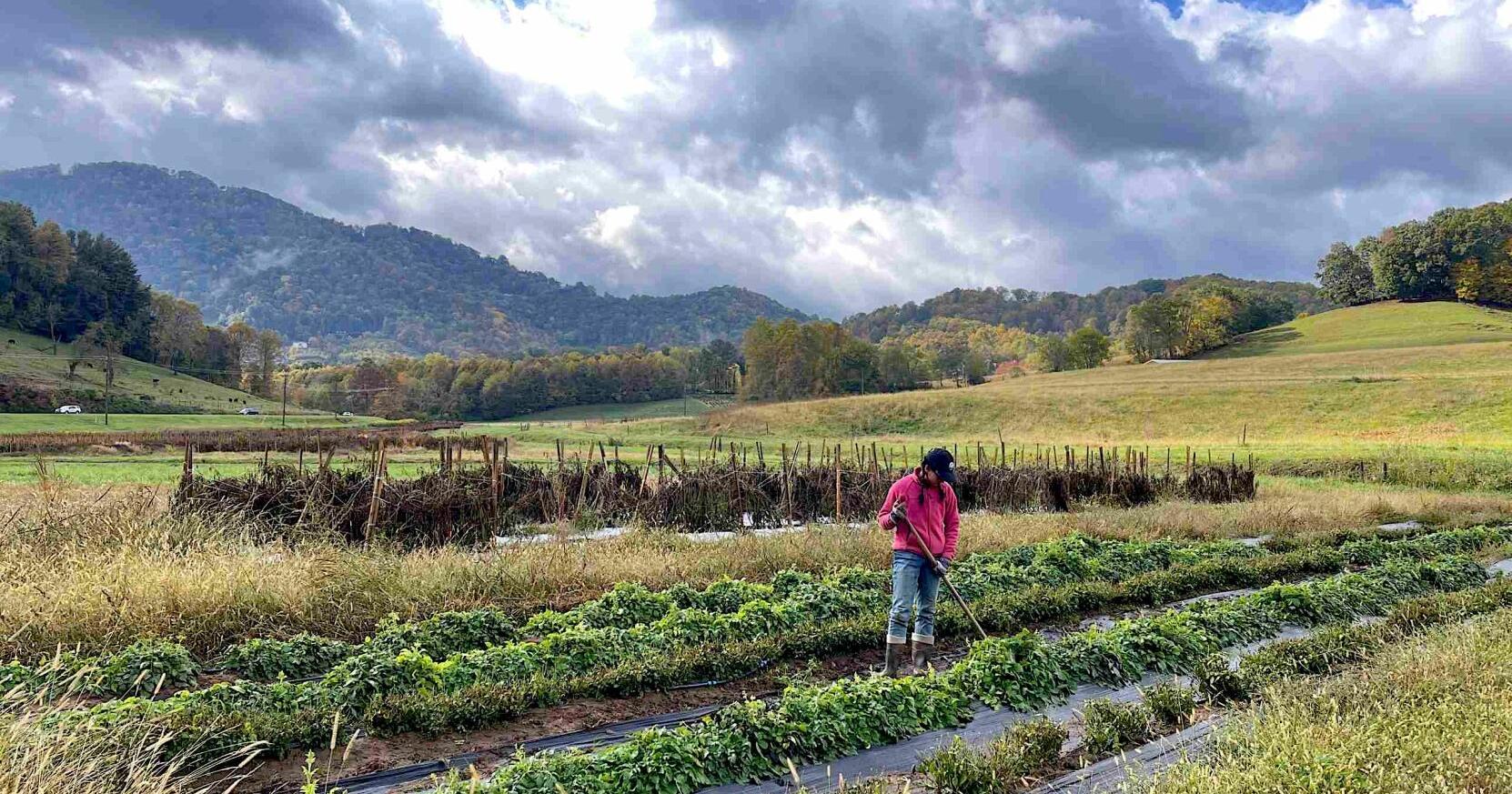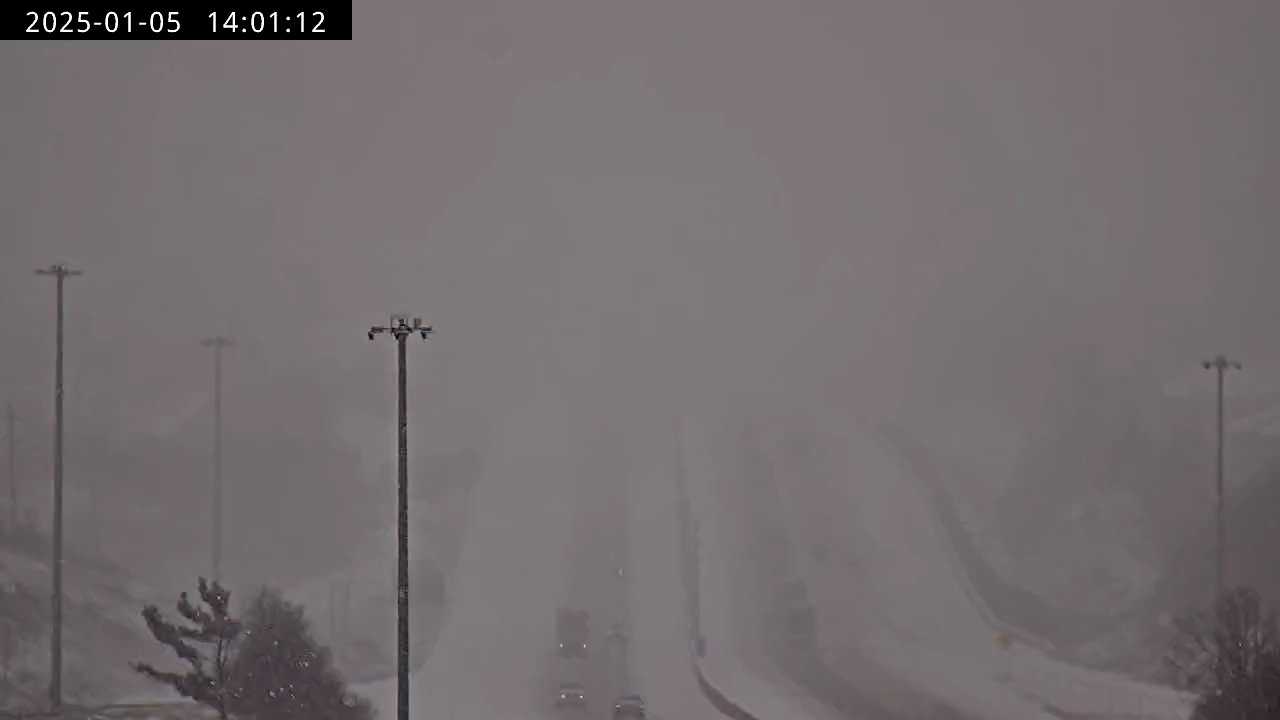
Major book publishers defeat Internet Archive appeal over digital scanning Reuters.com
source

Research assistant tends to Chinese medicinal herb root crops at the N.C. Department of Agriculture’s research station in Waynesville.
Research team transplants Chinese medicinal herbs for yield trials at the Mountain Horticultural Crops Research and Extension Center at Mills River in Henderson County in 2024.
Research assistant tends to Chinese medicinal herb root crops at the N.C. Department of Agriculture’s research station in Waynesville.
Research team transplants Chinese medicinal herbs for yield trials at the Mountain Horticultural Crops Research and Extension Center at Mills River in Henderson County in 2024.
A $96,925 grant from the N.C. Department of Agriculture’s New and Emerging Crops Program is focused on commercial production of traditional Chinese medicinal herbs in western North Carolina.
The grant was awarded this fall to North Carolina State University’s Department of Horticultural Science to build on research by the N.C. Alternative Crops and Organics Program, primarily at the NCDA’s Mountain Horticultural Crops Research and Extension Center in Mills River in Henderson County.
An NCDA news release said North Carolina is uniquely positioned to meet growing consumer, herb buyer and practitioner demand for domestic production of high-quality medicinal herbs. Examples include Ju hua and Chrysanthemum morifolium.
“North Carolina is suited to the production of many traditional Chinese medicinal herb species because of geographical similarity, but production information and recommendations for North Carolina growers are limited,” the release said.
“This project will build on current research by the N.C. Alternative Crops and Organics Program… by expanding field trials to a larger scale, increasing domestically available propagation stock, providing samples of North Carolina-grown herbs to buyers, facilitating buyer-grower relationships and developing production recommendations.”
The goal of the grant-funded initiative is to contribute to the limited commercial production resources available for growing Chinese herbs in North Carolina, said N.C. State University researcher Dr. Jeanine Davis, an associate professor and extension specialist in the NCSU Department of Horticultural Science. Davis is based at the research station in Mills River.
“Just like with so many other herbs, when people go to produce them commercially, the material available to them is all home-gardener information, and what works for a few plants or a little home garden isn’t necessarily practical or feasible on a commercial scale,” said Davis.
“We’re trying to help with production on a commercial scale and provide a new opportunity for farmers to explore a new crop.”
Much of the focus therefore is on yield trials to help determine productivity of the herbs in North Carolina, said Margaret Bloomquist, a research scholar in Davis’ program. Those trials are at the research station in Mills River and an NCDA research station near Waynesville.
The trials also are on two farms in Buncombe County, one focused on shade herbs and the other on sun-loving species of Chinese medicinal herbs.
Another focus is on sourcing and propagating the plants for the quantity needed for commercial production to address the lack of availability of seeds and planting stock for Chinese medicinal herbs in North America, Bloomquist said.
“Many of these species are perennial root crops with unusual requirements. These types of crops may present a learning curve for farmers, so we’re working on establishing best practices in regard to growing perennial root crops in our current agricultural system,” she added.
Efforts so far found that many of the herbs have few disease or insect issues at this scale and require little fertilizer relative to other crops. Bloomquist said the resulting low-input needed is appeals to small growers, those in vegetable production and those interested in organic farming.
The perennial nature of many of the herbs appeals to growers wanting to reduce labor and mitigate soil needs involved in turning over a field every season, she said. Some of the harvest timeframes are positive attributes because they fall during times when other crops don’t need to be harvested and they provide season extension to diverse operations.
Davis and Bloomquist said Asheville and surrounding areas ahave Chinese herb gardens and practitioners who use and sell Chinese medicinal herbs. Seminars and buy-and-sell events have been held to help growers connect with users, buyers and other growers.
Davis said a partnership with herbalist Thomas Avery Garran has been helpful. Garran lived in China for many years before returning to the United States. He helped translate a major Chinese medicinal herb book into English to help people like Davis and Bloomquist utilize its information.
“He’s been a great partner because he was able to – with all his contacts in China – help find sources for seeds for the project. He’s really knowledgeable about these plants. He is an herbalist, so he also knows how to use them,” Davis said, adding that he is better qualified to evaluate the quality of what is grown.
We’re used to working with crops like potatoes and tomatoes and peppers that all have USDA grade standards that tell you whether you’ve done a good job or not. Having these herbalists that really know the herbs come, they can smell it and taste it and look at it and give us a good quality assessment.”
A next step is to dig deeper into post-harvest handling such as washing and drying herb crops. Bloomquist said that could involve pursuing a follow-up grant. They’re focusing on the scope of the current project for now. Davis said the New and Emerging Crops Program grant made this possible.
“The biggest chunk [of the grant award] goes to paying the staff to work on the project,” Davis said. “So it gives us the staff to do this work, and it allows us to maintain people in the program to develop that continuity that we need so someone becomes an expert within our program.”
She said the grant also funded supplies and travel to test sites and to visit partners or field experts.
“Programs like mine don’t have operating budgets. When the public expresses an interest in something and wants us to work on something – whether it’s herbs or hops or ginseng – we have to go find the funding to make it happen,” Davis said. “It’s often hard to find funding for new crops. So this [New and Emerging Crops] program has been amazing to my program that exists primarily to do this – to explore new possibilities.”
Davis’ work on Chinese medicinal herbs in North Carolina goes back to at least the early 90s, when ginseng scientist Che Xizhe from China was working in her research program at the station in Mills River and started exploring whether any of vegetables or other plants on the station had medicinal properties.
By 1992, the curiosity led to working with Joe Hollis, who operated an apothecary and medicinal herb gardens called Mountain Gardens in the Mount Mitchell/Burnsville area. Exploration turned to research and Hollis was a consultant for Davis and her team until he died in November 2023.
“He was one of the most knowledgeable people about Chinese medicinal herbs that I’ve ever met,” Davis said. “We spent a lot of time with Joe talking about Chinese herbs and similarities of plants in China and here in North America.”
By the time Hollis died in the fall of 2023, Davis had begun the research effort that that received the NCDA New and Emerging Crops Program grant..
Davis and her team have for several years sought funding for researching Chinese medicinal herbs in North Carolina. In 2009, Mayland Community College offered a grant for initial research. That project involved Hollis, Barry Thorne of Golden Needle acupuncture and herbal supply near Asheville, some local extension agents and even a consultant in New York – Jean Giblett of High Falls Gardens.
Giblett encouraged Davis many times to do more exploration about whether Chinese medicinal herbs would grow well in North Carolina. She had her own experience with the topic, having worked with the University of Massachusetts at Amherst.
“Every time we met at a conference, she would bring it up [and say] ‘Jeanine, you need to do this,’” Davis explained. “And we wrote so many grant proposals together and with others for years trying to get funding, but nobody was interested because it wasn’t a thing yet.”
At the time, the New and Emerging Crops Program didn’t exist, nor did the USDA Specialty Crops Block Grant Program, which Davis has also used to fund projects. The grant from Mayland Community College made it possible to plant Chinese medicinal herbs in western North Carolina, to test their success and propagate plants.
“What we were really after was trying to see what plants would thrive where,” Davis said. “We found that some things did really, really poorly here in the Southern mountains, but you got up into a much higher elevation, and they did really well. When we had visitors come in from China they were not surprised at all by those results.”
In the years since that project, members of Davis’s crew continued to maintain the herbs that had been planted. Some additional funding helped with that maintenance and ongoing observations. Thorne continued to work with anyone growing Chinese medicinal herbs locally, and in his catalogue of herbs, he designated which herbs he sourced from the region.
“It’s still hard convincing practitioners that we can produce the quality (of herbs) that may be superior to material we’re getting imported,” Davis said. “So that led us to the 2023 New and Emerging Crops Program grant.”
Success! An email has been sent to with a link to confirm list signup.
Error! There was an error processing your request.
Have the latest local news delivered every morning so you don’t miss out on updates.
Receive our newspaper electronically with the e-Edition email.
Your comment has been submitted.
Reported
There was a problem reporting this.
Log In
Keep it Clean. Please avoid obscene, vulgar, lewd, racist or sexually-oriented language.
PLEASE TURN OFF YOUR CAPS LOCK.
Don't Threaten. Threats of harming another person will not be tolerated.
Be Truthful. Don't knowingly lie about anyone or anything.
Be Nice. No racism, sexism or any sort of -ism that is degrading to another person.
Be Proactive. Use the 'Report' link on each comment to let us know of abusive posts.
Share with Us. We'd love to hear eyewitness accounts, the history behind an article.
Success! An email has been sent to with a link to confirm list signup.
Error! There was an error processing your request.
Receive our newspaper electronically with the e-Edition email.
Have the latest local news delivered every morning so you don’t miss out on updates.
Sorry, there are no recent results for popular videos.
Sorry, there are no recent results for popular commented articles.
An N.C. House Select Committee is recommending that the General Assembly change a state law forcing districts to start school the Monday closest to Aug. 26 and end no later than the Friday clo…
Your browser is out of date and potentially vulnerable to security risks.
We recommend switching to one of the following browsers:


Hey there, friends! Today, I want to talk to you about an incredible film that really shook me to my core: *The Deliverance*, directed by the talented Lee Daniels. This movie features amazing performances from Glenn Close, Andra Day, Mo’Nique, and a fresh face, Anthony B. Jenkins. It tells a powerful story about faith, family, and the supernatural, based on the true experiences of Latoya Ammons, a mother whose children faced some serious dark forces.
**Plot Overview**
In *The Deliverance*, we meet Ebony Jackson, played by songstress Andra Day. Ebony is a mom trying to hold her family together while battling her own struggles with alcohol. Things take a terrifying turn when her children—Andre, Nate, and Shante—start to show signs of being possessed by evil spirits. Glenn Close awes as Alberta Jackson, Ebony’s strong and faithful mother, who tries to guide her family through this difficult time. The film also features powerful performances from Aunjanue Ellis-Taylor as Reverend Bernice James and Mo’Nique as Cynthia Henry, who works in child services.
Now, let me be real with you. I don’t usually watch horror movies because they can leave me feeling uneasy, but *The Deliverance* was different. I remember sitting there, feeling like I might have to turn it off, but then something shifted. As I watched, I realized this movie was about more than just scary moments; it was about the power of faith and the strength we find in believing.
When that woman fell to her knees and started speaking in tongues, I broke out into praising God. It was a moment of raw emotion that spoke to my spirit. It reminded me that when we call on Jesus Christ our Lord, even in our darkest hours, we can find protection and peace. I felt chills because I understood that the name of Jesus is powerful. When we believe and call out His name, nothing can stand against us.
**What Does Linda Think?**
So, what do I think about this movie? Well, I don’t see it as just another horror film. It’s a lesson about the reality of spirits and the victory we can achieve through our faith in God. The story of Latoya Ammons is a reminder that even when things seem impossible, we can overcome by knowing and trusting in God’s love.
The film does a great job of showing how real spiritual battles can be. It teaches us that we have authority over darkness when we stand firm in our faith. I believe this message is so important for everyone, especially for young viewers who may be searching for strength and guidance in their own lives.
*The Deliverance* is more than just a scary movie; it’s a powerful reminder of the strength we can find in our faith. It challenges us to reflect on our beliefs and shows us that, with God by our side, we can face any challenge that comes our way. I encourage everyone to watch this film—not just for the thrills but for the hope and lessons it offers. Remember, when we stand in faith, we are never alone, and we can overcome any darkness that tries to come against us. Stay blessed, my friends!

Our winter storm continues to move through Sunday. The region is under a Winter Storm Warning through Monday night. Travel will be treacherous this weekend and even near-impossible at times.
CLOSURES // LIVE RADAR // LATEST WEATHER ALERTS
See the latest forecast in the video player above
This story will be updated as the day goes on with the latest from the WLWT weather team.
3 p.m.: Several schools announce closures for Monday as winter storm continues to move in. See full list here
2 p.m.: Snow is already beginning to accumulate across the region, and will only get heavier. Road temperatures are below freezing so this will stick, especially on untreated surfaces.
1:30 p.m.: All state office buildings in Kentucky will be closed on Monday, according to the governor.
1 p.m.: The snow is starting to blanket roadways across Greater Cincinnati. Kentucky State Police reported a cruiser was hit on I-65, warning drivers to avoid travel. Police in Bellevue issued a similar warning after reporting multiple crashes.
71-75 in Kentucky right now right at the Split in Boone County. pic.twitter.com/AUB4fG8Lkl
12 p.m.: The Cincinnati Police Department has implemented its’ Inclement Weather Accident reporting procedure, meaning those involved in a non-injury auto accident, are asked to exchange information with the other driver(s) and report the accident at one of their district locations when able.
10:40 a.m.: Boone County has joined the list of counties that have declared a Level 1 snow emergency, effective immediately. A full list can be seen here.
10:15 a.m.: The flakes are beginning to fly, with snow beginning around 9:45 a.m. in areas such as Boone County and coming to downtown Cincinnati just after 10 a.m.
From meteorologist Allison Rogers: “Snow is moving in. When heavy snow and sleet falls, it brings an ice concern.”
Snow has begun to fall in many parts of Greater Cincinnati, including in Boone County, as a winter storm that's expected to bring major impacts enters our area. Latest updates: https://t.co/gnJys3iIqv pic.twitter.com/DTCEUkJr8d
9:15 a.m.: Carroll County, Kentucky – about halfway between Louisville and Cincinnati – is beginning to see snowfall.
Carroll County, KY this morning: pic.twitter.com/uDzhB9qMTw
9 a.m.: Meteorologist Allison Rogers says we’re still on track for a 10 a.m. snow arrival. This afternoon, as the heavier snow moves in, roads will “likely” deteriorate quickly.
Snow starts moving in around 10! Roads likely deteriorate quickly this afternoon as heavy snow moves in. pic.twitter.com/EcG22NKn33
In addition, Gallatin County has joined the list of counties that have declared a Level 1 snow emergency, which will be in effect until further notice. A full list of declared snow emergencies can be seen here.
8:30 a.m.: Crews across Greater Cincinnati are gearing up to deploy and treat roads in preparation for the storm.
In Bellevue, Mayor Charlie Cleeves says it’s all about keeping the streets safe for neighbors. They have four trucks ready to go, with a major focus on hills, as those roads are the most dangerous when slick.
On the other side of the Ohio River, in Madeira, 1,500 gallons of calcium brine and 1,000 tons of salt sit on standby.
Hear from officials in both cities from a report from our Richard Chiles this morning.
Our winter storm continues to move in Sunday and we are under a Winter Storm Warning through Monday night. Travel will become very difficult later today and even near-impossible at times.
Snow will continue to overspread the area into the afternoon. Road temperatures are below freezing so this will stick, especially on untreated surfaces. Snowfall rates of 1 to 2 inches per hour are possible this evening and this is when I expect roads to really go downhill. Visibilities will also be greatly reduced due to the heavy snow.
Some warmer air higher in the atmosphere will nudge in here from the south late Sunday night. This will provide several areas with sleet and freezing rain at times, the most concerning being areas near Owenton, east to portions of Mason and Robertson counties. This is where the freezing rain potential is highest and where we could see some power outages.
We switch back to snow Monday morning, with additional accumulation likely throughout the day. We’ll also be breezy with wind gusts up to 25 mph.
Totals as of now will be highest south of I-70. Five to 8 inches of snow looks possible in portions of Butler, Warren and Clinton counties — as well as Fayette, Franklin, and Union counties in southeast Indiana. Localized higher amounts will be possible with a heavier band of snow that will set up.
South of the Ohio River, 2-4 inches of snow and sleet look possible. Up to 0.25 inches of ice is possible in our southernmost communities. All totals are Sunday and Monday combined.
A cold stretch settles in through the first full week of January. By Wednesday, wind chills will be in the single digits and dip below zero for Thursday morning. This lingers through the rest of the week.
Hearst Television participates in various affiliate marketing programs, which means we may get paid commissions on editorially chosen products purchased through our links to retailer sites.

Written by Satata Karmakar |Published : January 5, 2025 5:19 PM IST
HMPV In India: Human metapneumovirus (HMPV) is not a new virus and has been known for over 2 decades now. Yes, you read that right! The current virus threat sparking fears of another pandemic and potential lockdown is not new to India. According to a recent statement from experts, the country has already experienced an outbreak of this virus in the past and successfully managed to contain it.
As China battles a sudden surge in HMPV cases, Indian health experts have reportedly claimed that the virus has been observed in India on multiple occasions, particularly during the winter season. Speaking to the media, a renowned pediatrician at Sir Ganga Ram Hospital, Dr. Suresh Gupta, said “The HMPV is not a new virus and has been known for over 2 decades now. The virus is typically observed during the winter season and behaves similarly to influenza or a common viral fever.” He further added, “Most cases present with symptoms such as cold, cough, and fever, which are self-limiting and manageable with general medicine at home. Children rarely require hospitalization, as the infection is generally mild.”
Human metapneumovirus (HMPV) is a common respiratory virus that mainly targets the lower and upper respiratory parts of the body after evading the immune system. After the incubation period, the virus can lead to infections inside the lungs, triggering pneumonia-like symptoms.
More News
HMPV is a seasonal disease that usually occurs in the winter and early spring, similar to Respiratory Syncytial Virus (RSV) and the flu. HMPV is not a newly discovered virus. It was first discovered in 2001, the US Centers for Disease Control and Prevention (CDC) said.
Known for causing respiratory illnesses, the HMPV can trigger some serious symptoms such as:
Addressing the media, top health officials said, “So far, the cases we have seen here have been mild. The strain of this virus detected in India is generally considered mild. It primarily presents symptoms of mild viral fever.”
Taking cognizance of the situation, and a sudden spike in the HMPV cases in China, the Health Ministry said that India is keeping a close watch over the situation through all available channels and has also requested the WHO to share timely updates.
In order to prevent the virus from spreading, the officials have taken certain measures — India has set up laboratories for testing HMPV cases (this count has been e increased to tackle an outbreak). Also, the Indian Council of Medical Research (ICMR) has confirmed that they will track HMPV trends throughout the year in order to avert any unusual surge in HMPV cases. A meeting of the Joint Monitoring Group (JMG), chaired by the Directorate General of Health Services, took place on Saturday to discuss the matter.
In Telangana, the state government has also issued a list of do’s and don’ts that include — washing hands regularly with soap and water or using alcohol-based sanitizer, avoiding crowded places, and keeping a safe distance among other precautions.
In Kerala, Health Minister Veena George said the state government is closely monitoring the news reports about the massive outbreak of viral fever and respiratory infection in China and said there is no need to panic as of now.
Don’t Miss Out on the Latest Updates.
Subscribe to Our Newsletter Today!
Enroll for our free updates
Thank You for Subscribing
Thanks for Updating Your Information
By clicking “Accept All Cookies”, you agree to the storing of cookies on your device to enhance site navigation, analyze site usage, and assist in our marketing efforts. Cookie Policy.

The Internet Archive has lost its appeal in the copyright case against Hachette and three other publishers. The Second Circuit Court of Appeals affirmed the previous decision, from March 2023, that the Internet Archive’s Open Library program qualifies as copyright infringement. Hachette, HarperCollins, Penguin Random House, and Wiley initially filed a lawsuit against the popular nonprofit organization in 2020.
“This appeal presents the following question: Is it ‘fair use” for a nonprofit organization to scan copyright-protected print books in their entirety, and distribute those digital copies online, in full, for free, subject to a one-to-one owned-to-loaned ratio between its print copies and the digital copies it makes available at any given time, all without authorization from the copyright-holding publishers or authors?” Wednesday’s decision reads. “Applying the relevant provisions of the Copyright Act as well as binding Supreme Court and Second Circuit precedent, we conclude the answer is no.”
The Internet Archive is a longstanding organization that preserves and provides access to digitized content, beginning in 1996 to save the “ephemeral” content of the Internet. In its mission to “provide Universal Access to All Knowledge,” the org expanded to digital versions of other published works, with “special attention” paid to books. “Not everyone has access to a public or academic library with a good collection, so to provide universal access we need to provide digital versions of books,” IA states on its website. “One of the Internet Archive’s missions is to serve people who have difficulty interacting with physical books, so most of our digitized books are available to people with print disabilities.”
The court rejected most of the Internet Archive’s defense, including the notion that the archive provides a public service. “While IA claims that prohibiting its practices would harm consumers and researchers, allowing its practices would―and does―harm authors,” the decision reads. “With each digital book IA disseminates, it deprives Publishers and authors of the revenues due to them as compensation for their unique creations. Though IA and its amici may lament the consolidation of editorial power and criticize Publishers for being motivated by profits, behind Publishers stand authors who are entitled to compensation for the reproduction of their works and whose ‘private motivation’ ultimately serve[s] the cause of promoting broad public availability of literature, music, and the other arts.”
The appeal decision did differ from the initial ruling that IA was engaged in commercial activity because it accepts donations, noting that such precedent “would greatly restrain the ability of nonprofits to seek donations while making fair use of copyrighted works.” However, the appeal was rejected on every other front. “The parties in this case represent potentially serious interests. On the one hand, eBook licensing fees may impose a burden on libraries and reduce access to creative work. On the other hand, authors have a right to be compensated in connection with the copying and distribution of their original creations,” the court concludes, citing the Copyright Act. “IA asks this Court to bless the large scale copying and distribution of copyrighted books without permission from or payment to the Publishers or authors. Such a holding would allow for widescale copying that deprives creators of compensation and diminishes the incentive to produce new works.”
The group of publishers was organized in its lawsuit by the Association of American Publishers. “Today’s appellate decision upholds the rights of authors and publishers to license and be compensated for their books and other creative works and reminds us in no uncertain terms that infringement is both costly and antithetical to the public interest,” said AAP president and CEO Maria Pallante, in a statement (via Publisher’s Weekly). “If there was any doubt, the Court makes clear that under fair use jurisprudence there is nothing transformative about converting entire works into new formats without permission or appropriating the value of derivative works that are a key part of the author’s copyright bundle.”
After the initial decision in 2023, Internet Archive founder Brewster Kahle said in a statement, “Libraries are more than the customer service departments for corporate database products. For democracy to thrive at global scale, libraries must be able to sustain their historic role in society—owning, preserving, and lending books. This ruling is a blow for libraries, readers, and authors and we plan to appeal it.” On Wednesday, IA encouraged users to “open letter to publishers, asking them to restore access to the 500,000 books removed from our library.” In a statement, the organization said, “We are disappointed in today’s opinion about the Internet Archive’s digital lending of books that are available electronically elsewhere. We are reviewing the court’s opinion and will continue to defend the rights of libraries to own, lend, and preserve books.”
GET A.V.CLUB RIGHT IN YOUR INBOX
Pop culture obsessives writing for the pop culture obsessed.
© 2025 Paste Media Group. All Rights Reserved